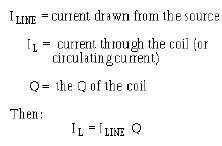1-27
Given:
Again, if the Q were 100, the circulating current would be 100 times the value of the line current.
This may help explain why some of the wire sizes are very large in high-power amplifying circuits.
The impedance curve of a parallel-resonant circuit is also affected by the Q of the circuit in a manner
similar to the current curve of a series circuit. The Q of the circuit determines how much the impedance is
increased across the parallel-LC circuit. (Z = Q
XL)
The higher the Q, the greater the impedance at resonance and the sharper the curve. The lower the Q,
the lower impedance at resonance; therefore, the broader the curve, the less selective the circuit. The
major characteristics of parallel-RLC circuits at resonance are given in table 1-2.

